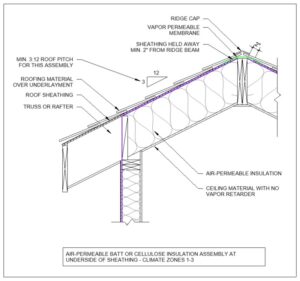All of our projects address the thermal envelope of a building which is a critical decision process that we help facilitate among owners and builders for residential and commercial projects alike. Like many building components, weighing out the various products available is not always cut and dry. While typical fiberglass batt insulation has been an industry standard for decades because it is a relatively inexpensive material to purchase and install, there are other materials out there that provide superior performance but are of course at a more premium cost.
Low and high density foams, or open cell and closed cell foam insulations, are gaining more popularity because of their higher performance in creating a tight but also efficient thermal envelope over fiberglass batt and even cellulose. Both are excellent in filling up gaps in hard to reach spaces and cavities but are not equal in their performance. Their names help in describing the variation in their technology where open cell foam consists of very tiny cells that are not completely closed and when applied, expands more, is less dense, so therefore less of the material is needed in the same amount of volume or cavity as compared to closed cell which inherently has very tiny and compact closed cell walls creating even greater thermal efficiency. Because of this difference in their structure and density, open cell foams have a R-values near 3.8 per inch and closed cell near 6.8 per inch and vary in density at around 0.5 lb./cu. ft and up to 2.0 lb./cu. ft., respectively. Also because the cells are closed in the higher density material, it affords even greater sound attenuation, resistance to air infiltration and permeability, or water vapor transfer because air is trapped within the little cells.
That’s not to say open cell foam doesn’t have it’s place in a design strategy and can be considered a middle ground approach to take when cost is a factor in lieu of even less efficient fiberglass batting. Another middle ground approach that we more commonly recommend is to apply a combination of closed cell and fiberglass batt insulation. For example, in a 2×6 stud wall one inch of closed cell foam with R-15 batting can provide an overall R-value of 22. In this way, a the structure has the advantage of a tight envelope with respect to air infiltration, provides a comparable R-value to just batt alone, and a significant savings in cost were just foam used. It is however worth noting that while the up front cost of going with closed cell is greater, they real payoff comes down the road in recapturing the cost of heating or cooling the structure years into use due to an overall higher R-value of the thermal envelope.
Varying applications also play a role in which to use and it would not be uncommon to use both open and closed cell in varying degrees throughout a building. For example, open cell is not recommended where a lot of moisture can exist or below grade where it is possible that it may come in contact with water. The cells are partially open, therefore it becomes like a sponge and negates it’s value as an insulator not to mention mold issues could result if it cannot dry out quickly enough. And using closed cell in places where space is limited but calls for the greatest R-value per inch possible is advantageous as well.
In summary, many variables are taken into account when making a choice among open cell and closed cell foam insulation. Short terms cost tends to drive the decision but balancing cost with performance is inherently at the crux for arriving at the best solution.









